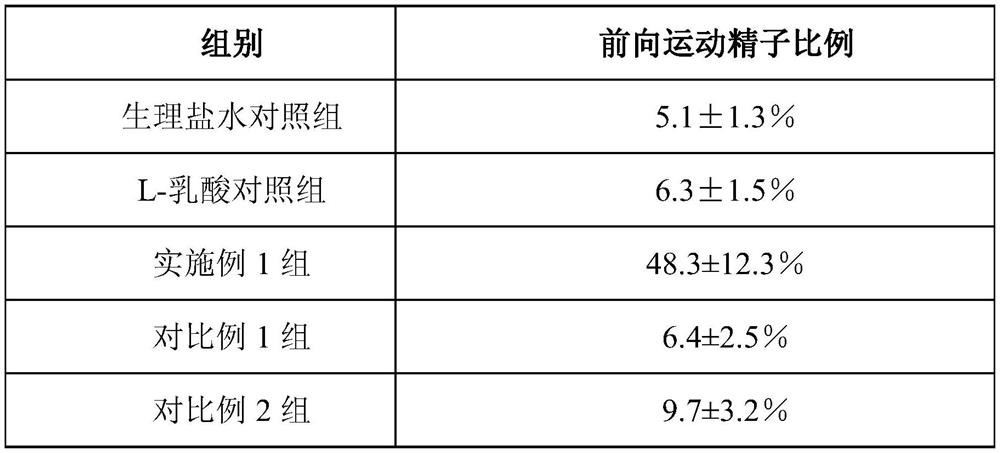A method for detecting sperm acrosome reaction
An acrosome reaction and sperm technology, applied in the field of sperm detection, can solve problems such as rapid detection limitations, and achieve the effect of improving efficiency
- Summary
- Abstract
- Description
- Claims
- Application Information
AI Technical Summary
Problems solved by technology
Method used
Image
Examples
Embodiment 1
[0028] A test reagent for sperm acrosome reaction, characterized in that it includes sperm capacitation treatment solution, acrosome reaction induction solution and staining solution;
[0029] The preparation method that described sperm capacitation treatment liquid contains Lactobacillus casei LC-N235 fermentation supernatant is:
[0030] (1) Take Lactobacillus casei LC-N235 and inoculate it into MRS solid medium to streak, culture at 37°C for 24 hours, pick a single colony with good growth in the plate and inoculate it into MRS liquid medium for activation, culture conditions: 32°C, 220r / min, after 24 hours of cultivation, it can be used as 1.0*10 7 (CFU / ml) Lactobacillus casei LC-N235 seed solution;
[0031] (2) Inoculate the seed liquid obtained in step (1) into the fermentation medium according to the inoculum size of 3%, and the fermentation temperature is 30°C. After 25 hours of fermentation and cultivation, centrifuge at 1000rpm for 20min, take the supernatant, filter...
Embodiment 3
[0041] The freshly taken semen was placed in a 37°C water bath for 0.5h to completely liquefy it, and then subjected to density gradient centrifugation to obtain high-motility sperm clusters to remove pollutants such as white blood cells, germ cells, and dead sperm.
[0042] Set 1 normal saline control group, 1 L-lactic acid control group (the aqueous solution of L-lactic acid of 3.5g / L), contain 3 detection groups of embodiment 1 and embodiment 2, each group is all set to 2 tubes ( for incubation at different times).
[0043] The control group was 1ml of semen diluted with normal saline, with a concentration of 1×10 6 motile sperm / ml; the detection group uses the sperm capacitation solution obtained in Example 1 and Example 2 to dilute the sperm into a concentration of 1×10 6 Motile sperm / ml suspension, each tube contains 1ml. The sperm suspensions of the control group and the test group were kept at 37°C, CO 2 Incubate in the incubator for 15 minutes and 3 hours, respecti...
Embodiment 4
[0048] Example 4 Detection of Weak Motility Sperm Motility Improvement
[0049] (1) Equilibrate the sperm capacitation solution obtained in Example 1 or Example 2 at a temperature of 37° C. for 2 hours;
[0050] (2) Put the semen collection cup with weak motility semen in a 37°C water bath for 0.5h to obtain liquefied semen;
[0051] (3) Use the preheated sperm capacitation solution obtained in Example 1 or Example 2 to wash and dilute the liquefied semen, and centrifuge at 300g for 10 minutes to obtain separated weakly motile sperm;
[0052] (4) Separate the weakly motile sperm according to 1×10 7 Add the amount of CFU / mL to the preheated sperm capacitation solution obtained in Example 1 or Example 2, and incubate at 37° C. for 120 min to obtain the incubated sperm.
[0053] (5) Set up two control groups at the same time (normal saline group with a temperature of 37°C and an L-lactic acid aqueous solution group with a concentration of 3.5g / L), wash, dilute and incubate weak...
PUM
 Login to View More
Login to View More Abstract
Description
Claims
Application Information
 Login to View More
Login to View More - R&D
- Intellectual Property
- Life Sciences
- Materials
- Tech Scout
- Unparalleled Data Quality
- Higher Quality Content
- 60% Fewer Hallucinations
Browse by: Latest US Patents, China's latest patents, Technical Efficacy Thesaurus, Application Domain, Technology Topic, Popular Technical Reports.
© 2025 PatSnap. All rights reserved.Legal|Privacy policy|Modern Slavery Act Transparency Statement|Sitemap|About US| Contact US: help@patsnap.com



